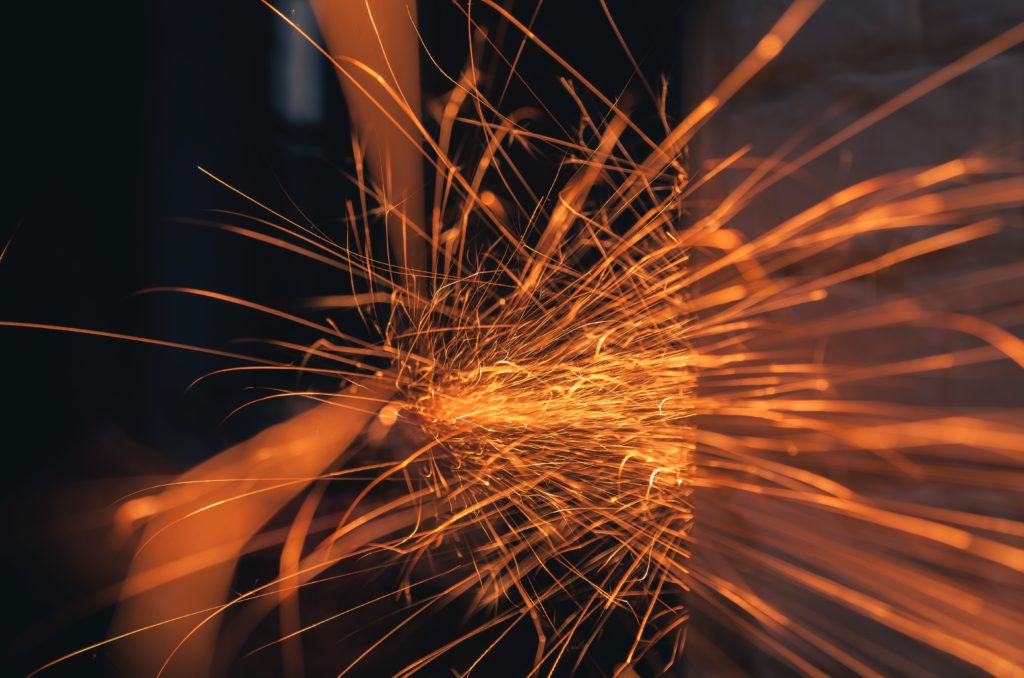Use of stainless steel structural components has been growing as structural engineers, architects, building owners, manufacturing plants, and other decision-makers become aware of its life cycle cost and strength advantages. Stainless steel also provides better high-temperature strength than carbon steel in case of fire. Examples of stainless steel in structural applications can be found in the SSINA brochures Stainless Steel For Structural Applications and stainless Steel for Handrails, Railings & Barrier Applications. Stainless steel structural components are available but in a more limited range of sizes and shapes than what is normally available in structural steel. There are also design differences that must be taken into consideration. This resource center was developed to make it easier to identify suppliers, standard shapes and sizes, appropriate specifications, and review basic design data.
Stainless steel is 100% recyclable and has a high scrap value.

Use of stainless steel structural components has been growing as structural engineers, architects, building owners, manufacturing plants, and other decision makers become aware of its life cycle cost and strength advantages. Stainless steel also provides better high temperature strength than carbon steel in case of fire. Examples of stainless steel in structural applications can be found in the SSINA brochures Stainless Steel For Structural Applications and Stainless Steel for Handrails, Railings & Barrier Applications.
Stainless steel structural components are available but in a more limited range of sizes and shapes than what is normally available in structural steel. There are also design differences that must be taken into consideration. This resource center was developed to make it easier to identify suppliers, standard shapes and sizes, appropriate specifications, and review basic design data.
Maintenance and inspection costs are significantly reduced when you use stainless steel because of the need to reapply protective coatings, maintain galvanic protection, or closely monitor corrosion-related structural deterioration. Furthermore, the term “corrosion allowance” has no meaning because stainless steel does not suffer gross corrosion, which can allow the use of reduced section sizes. When these factors are taken into consideration, stainless steel is often the most cost effective choice for long-term applications in corrosive exterior and interior environments. Stainless steel is 100% recyclable and has a high scrap value. In addition, there is no need for coatings, which can out-gas, contaminate the environment or production lines as they deteriorate, and make recycling more difficult and expensive. There are also no corrosion products to contaminate the environment. These characteristics make stainless steel a green material. Additional information about stainless steel’s environmental advantages can be found in the SSINA publications Stainless Steel The Green Material and Environmental Brochure on Stainless Steel.
It should be noted that some sizes are easier to make or more readily available than others and this can have an impact on the component cost.
It is usually the most cost-effective to use standard stocked component sizes, particularly when purchasing smaller quantities or when rapid delivery is required. Custom sizes can be produced but they may be more expensive and require longer lead times and have minimum order quantities. It should be noted that some sizes are easier to make or more readily available than others and this can have an impact on the component cost. A slight design change to a smaller or larger size may result in significant cost savings.
The most commonly stocked stainless steel structural components are plate, sheet, rod, and bar. A variety of sizes are available in Type 304 from most North American stainless steel service centers. Type 316 is also commonly available but the stocked size range is often more limited. The availability of these product forms in other stainless steel grades will vary. Service centers and producers can be identified using the Metal Service Center Institute’s Member Database.
Light gauge structural components cold formed from sheet such as angles and channels can be produced in large quantities by roll forming or in small quantities by brake forming. Unless a particular component is ordered regularly, they are not stocked. Please go to our online lists of suppliers if you need larger quantities. Roll forming is generally the most economical method of producing larger quantities.
Heavier gauge hot and cold formed angles, channels, tubing, and other structural components are considered a specialty item. They are stocked by specialty service centers and some of the manufacturers. Since it can sometimes be difficult to identify suppliers and service centers that stock these components, SSINA has developed lists of commonly stocked sizes, manufacturers, and service centers to make it easier to find and use these components.
The manufacturer descriptions provide contact information including website links, production capabilities, items they stock, and additional products that can be produced but are not commonly stocked. Lead times for special orders can range from five days to several months depending on the supplier, order size, and order backlog.
The service centers are listed both geographically and alphabetically. Their listings include contact information and website links, locations, and the types of products stocked. Some have locations throughout North America and others only have one location. When service centers have multiple locations, only the headquarters contact information is shown. Please contact their headquarters to find the location closest to your project which stocks structural components.
If you want to determine commonly stocked sizes, please see our lists of angles, beams, channels, pipe, tees, and round, square, and rectangular mechanical/structural tube. These lists represent the common sizes and grades that service centers or manufacturers reported stocking on a regular basis. Some items are more widely stocked than others. These lists are only meant to be a guideline. There is no guarantee that these items will be in stock at the time of your order and additional sizes may also be available, so please confirm availability before proceeding with your design.
Stainless steels have excellent ductility and strain hardening characteristics and can absorb considerable impact without fracturing.

The stress-strain behavior of stainless steel differs from carbon steel in several respects. The most important difference is that carbon steel typically exhibits linear elastic behavior up to a clear yield stress point while stainless steel has no well-defined yield stress point. After carbon steel reaches a clearly visible yield stress point, its strength plateaus. Stainless steel’s rounded stress-strain curve does not plateau and a 0.2% offset strain level is used to define yield strength.
Stainless steels have excellent ductility and strain hardening characteristics and can absorb considerable impact without fracturing. Their strength level also increases with work hardening.
Basic stainless steel mechanical and physical property design data is provided in Imperial and metric units. The most commonly used stainless steels are Types 304 and 316. Data has also been provided for 2205, which offers higher strength and corrosion resistance. Sources of detailed design guidelines and the relevant specifications are identified in the following section.
Stainless steel is in the European, Japanese, and Australian structural design codes. Unfortunately, it has not yet been included in North American structural design codes but stainless steel structural members are covered by numerous specifications.
ANSI/ASCE 8-90 is the Specification for the Design of Cold-Formed Stainless Steel Structural Members. This specification is widely used around the world for cold-formed structural stainless steel design. The Steel Construction Institute (SCI) in Great Britain has done considerable research in stainless steel structural design and is an excellent source of information. NiDI distributes a free brochure summarizing their research and design data. Additional detailed design information including design tables can be purchased from SCI.
Production of the structural components and their strength and tolerance requirements are covered by numerous ASTM specifications. These should be referenced when specifying and ordering these products. A list of specifications and guidelines has been provided for your reference. This includes publication descriptions, contact information and website links.
Production is fast and lead times are usually fairly short, particularly if existing tooling is used.

Stainless steel structural components can be hot and cold formed. The most common fabrication methods are brake forming, roll forming, forging, welding, and extrusion. Brief descriptions of these processes are provided below. Additional information can be found in the SSINA publication Stainless Steel Fabrication .
Cold Forming
When stainless steel is brake or roll formed cold, it work hardens so power requirements will be higher than for carbon steel. In addition, stainless steel has greater spring back than carbon steel and must be bent more to achieve the desired angle. The high ductility of stainless steel allows small radii to be formed, but as a general rule the bend radii should not be less than twice the thickness for Types 304 and 316 or two and a half times the thickness for 2205.
Brake forming can be used to produce either simple or complex shapes from cold stainless steel. Cut lengths of sheet are placed in a brake press and moved between each bend. A single bend will produce an angle shape. Multiple stage operations are needed for more complex shapes such as channels, tees, beams, and other shapes. This makes brake forming fairly labor intensive and it is usually most economical for small quantity runs. Section length and thickness is limited by the size of the brake press.
Roll forming can be performed on either hot or cold stainless steel. It is a continuous process that employs a series of paired top and bottom roller dies to progressively shape a flat strip of metal into a desired contour such as a channel, an angle, or a tube. It is a high-speed production process that can produce uniformed cross sectional dimensions throughout the length of the part.
Roll formed profiles must have a uniform cross section along its entire length, and the material thickness must be consistent throughout. Minimum order quantities of 5,000 feet or more are usually necessary to make roll forming economical. Unlike brake forming there are no section length limitations. Roll forming can produce different lengths of the same part with the same set of tooling.
Stainless steel extrusions are produced by forcing hot stainless steel through a die. The near-net shapes that are produced can be used as-is or machined. Production is fast and lead times are usually fairly short, particularly if existing tooling is used. The minimum order size for extruded components is usually less than what is required for roll-forming, usually around 1000 pounds. The process can be used to produce a wide range of shapes including angles, channels, beams, tees, and more unusual and complex shapes.
Stainless steel structural members are most commonly welded using plate, extrusions, or heavier brake or roll-formed sections when small quantities or very large sections are required and the item is not stocked. All welding should be done in compliance with the AWS structural stainless steel welding specification (see the specifications section ).